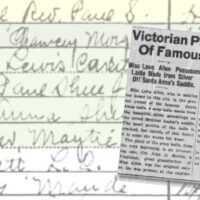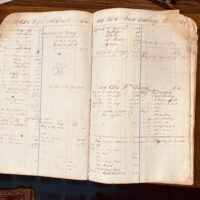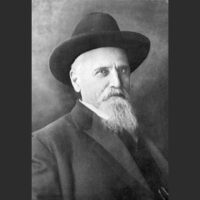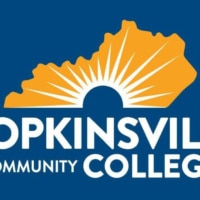Thousands of people crowd the streets — bundled up with hats and scarves — to watch Santa float through the intersection atop a giant inflatable train. The balloon is so massive that it barely scrapes under the traffic light at Ninth and Main streets.
Kids and adults alike cram into every window of Higgins Drug Store, all hoping to get the best view of this sight. Tinsel is strung high above the masses. A photographer gets a clear, birds-eye view from above Charles Department Store and …
CLICK!
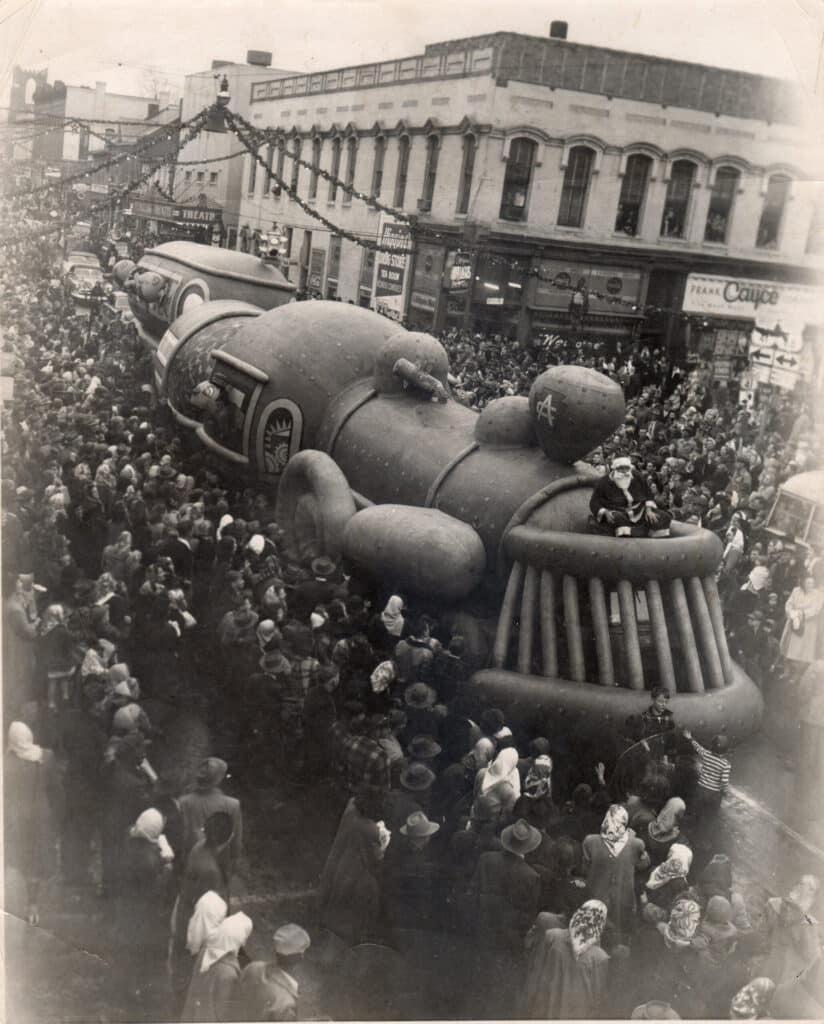
A spectacular moment is captured.
This month’s picture transports us back to Tuesday, Dec. 2, 1949, when Hopkinsville held its biggest, most dazzling parade to date. It was this year and the following year that Hoptown’s holiday parade featured enormous balloons as its main attraction. A few photographs survive in the collection of our dear William T. Turner, and this one is by far my favorite. I mean, just look at it! If it weren’t for the obvious Hopkinsville landmarks like Higgins Drug Store, the Frank Cayce Company, and the sign of the Princess Theater, I could easily be convinced that I was looking at a picture taken in New York City.
History of Hopkinsville’s Christmas parade
Hopkinsville’s first Christmas parade made its way down Main Street in 1932. In the midst of the Great Depression, Hoptown mustered up the holiday spirit to decorate downtown with lights that same year, too. Parades continued through the ‘30s and ‘40s, but nothing prepared the community for the extravaganza that the 1949 parade would bring. Sponsored by the Chamber of Commerce and financially supported by downtown businesses, this parade was destined to be something much, much bigger.
W.A. “Bill” Schmidt can be credited as the mastermind and driving force behind this elaborate display. Schmidt, a civic leader and owner of Jordan Furniture Company, served as the Chamber president that year. In an interview with Jennifer P. Brown in 1992, Schmidt recalled that he “just picked up the telephone one day, called Macy’s and asked them if we could use some of their balloons for our Christmas parade.”
And, wouldn’t you know it, they agreed.
Origins of parade balloons
A note on the Macy’s Thanksgiving Day Parade: it was first held in 1924, with the first balloon — Felix the Cat — joining the lineup in 1927. The New York City parade became a recognizable cultural phenomenon when it was featured in the movie Miracle on 34th Street in 1947. The parade was broadcast on national television in 1948.
The next year, balloons made their way through our own downtown.
According to the Kentucky New Era in 1949, the balloons came from the Jean Goss Company out of Pittsburgh. The set included approximately 20 balloons of varying sizes — the largest of which was the train we see pictured here. In bigger cities, the train stretched with additional cars, but they limited its capacity for Hoptown’s streets. A kangaroo, soldiers, a dragon, a clown face and six inflated heads rounded out the spectacle. Eighty high school boys were commissioned to be handlers and keep the balloons under control.
The balloons may have been the main attraction, but they weren’t the only entertainment strutting down the street. Six marching bands — from Camp Campbell and Hopkinsville, Attucks, Trigg County, Todd County, as well as Princeton high schools — provided “more music than ever has been heard in Hopkinsville at one time before.” Observing a half day in honor of the afternoon parade, schools built holiday floats to add to the magic of the event.
Jimmy Wilkins, a local magician later known by the stage name Wandi, drove in the parade blindfolded, too. And Myra Sapinsley’s kindergarten class made their parade debut — dressed in costumes as toys on Christmas morning — a tradition that would continue in parades for years to come.
But no tractors or farm implements, in the words of the organizers, “which so often have been used to lengthen the parades here” were allowed. The newspaper reported that “only entries of definite spectator interest will be used this year.”
Parking meters were free all day, and downtown businesses agreed to stay open until 8 p.m. Local merchants painted “Welcome Camp Campbell” signs on their storefronts and chipped in money to buy candy for Santa to give out to kids after the parade (which apparently resulted in complete mayhem due to the overwhelming size of the crowd).
Estimates of the crowd size reached up to 30,000 — quite the influx for a city whose population was just over 12,500 at the time. One of those in that huge crowd was Wiliam Turner, watching from inside a sweet shop near the corner of Ninth and Virginia streets. His most vivid memory was witnessing a wind gust as it lifted the high school boys handling one of the big balloons clear off the ground. Thank goodness they held tight to those ropes!
The parade was a big hit, obviously. So big that the Chamber of Commerce booked the balloons for a sequel. The 1950 parade was held on Tuesday, Dec. 5, and was the city’s first to be held at night. It featured more balloons — the largest of which was a pipe organ that was 135 feet long. The same display made its way through the streets of Chicago the day before it graced the streets of Hopkinsville. Soldiers from Fort Campbell (now a permanent installation) provided the additional manpower to wrangle these massive inflatables.
The weather didn’t cooperate, however. It started snowing at 3 p.m., and two regional bands dropped out for fear of deteriorating road conditions. Attendance was still high — but failed to meet the crowd size of the year before.
A parade lull
In 1951, Hopkinsville did not have a Christmas parade because no group wanted to shoulder the responsibility or the cost involved. Lucky for us, the lull only lasted that one year, and a downtown Christmas parade hasn’t missed a year since 1952.
No picture has captured my imagination quite like this one. To have been on the street that day, in that crowd, to watch these massive balloons take over downtown Hoptown! It’s like a fantasy to me. And it is a little piece of local history that I want to see remembered.
How great is Hopkinsville? So great that balloons like the ones used in the Macy’s Thanksgiving Day Parade were used in OUR parade! It’s little tidbits like these — factoids, as one of my favorite friends and scholars likes to say — that make our history so dang interesting.
When I started this column last December, I knew that I had to write about this picture, but I wanted to save it for the end. A grand finale, of sorts.
Starting in January, this “Snapshots in Time” column is going to transition a bit. For the past 13 months, I have used photographs to take us down historical rabbit holes. In 2023, I am going to use artifacts from the collection of the museum. If a picture is worth a thousand words, I wonder how many an artifact is worth. I hope you’ll join me to find out.
In the meantime, take a few minutes to study this photograph again. Imagine yourself in that crowd. Your head is wrapped in a scarf or sporting a fedora. You are jammed uncomfortably close to your fellow parade-goers as you all strain to see the full magnitude of the sensation coming down the street. The air is cold, and the voices of thousands fill the air as Santa rolls by on his inflatable chariot. And for a moment, you are surrounded by the joy and life that a true Hopkinsville Christmas can bring.
Merry Christmas, friends!
